Excerpted from Katie Workman’s Dinner Solved!.
Just hold back on the cayenne and dry mustard in the flour coating to make a less-spicy fried chicken.
During long car rides and other stretches of time when we’re looking for ways to entertain ourselves, subjects come up like, “If you had a million dollars, what would you do first?” Or, “If you could pick one meal to eat for the rest of your life, what would it be?” In those food-centric conversations (I’m not saying they happen all the time, but as you might imagine . . .), the words fried chicken have been known to make an appearance. Right up there in the pantheon of best foods on the planet.
I wouldn’t say I’m a big deep fryer in general, because it’s messy and hard to justify on a regular basis. This is why I start the chicken in the pan, but finish it in the oven. This is also handy because when I am making fried chicken, I am usually making it for a crowd, so the notion of standing over a pot of bubbling oil for hours on end does not work for me.
The cornstarch gives the crust extra crunch, always a good thing in fried chicken. The key tips are to not crowd the pan, and to keep the oil at a lively bubble, but not smoking hot, so that the skin really crisps up. Start this recipe a day before you are going to cook it; the chicken needs to brine overnight.
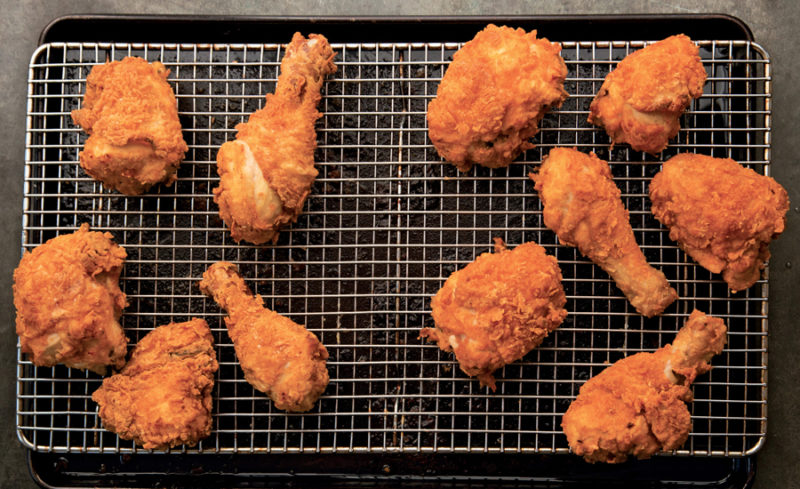
Oven-Fried Chicken
Serves 8
Ingredients
- 8 cups (2 quarts) buttermilk
- ½ cup plus 2 teaspoons kosher or coarse salt
- 2 tablespoons freshly ground black pepper
- 6 pounds skin-on, bone-in chicken pieces (divide drumsticks and thighs; cut large breast halves in half)
- 5 cups canola or vegetable oil or more as needed, for frying
- 3 cups all-purpose flour
- ¼ cup cornstarch
- 2 tablespoons paprika
- 2 tablespoons dry mustard powder
- 1 tablespoon cayenne pepper
Instructions
- Combine the buttermilk, the ½ cup salt, and 1 tablespoon of the pepper in a very large bowl, stirring well to dissolve the salt. Add the chicken pieces to the bowl, making sure the chicken is thoroughly covered. Cover with plastic wrap and refrigerate for 24 to 36 hours, turning the pieces once or twice to make sure they’re evenly submerged.
- Preheat the oven to 350°F. Place wire cooling racks on each of 2 rimmed baking sheets.
- Combine the flour, cornstarch, paprika, mustard powder, cayenne, and remaining 2 teaspoons salt and 1 tablespoon pepper in a large bowl. Remove the chicken from the buttermilk, letting the excess liquid drip off (as you do, smooth out the skin, so it covers the chicken as best as possible). Dip each piece in the flour mixture to coat it very thoroughly. Shake off the excess, then place the chicken on the wire racks. (You will finish baking the chicken on the same wire rack–lined baking sheets.)
- Pour oil to a depth of 2 inches into a Dutch oven, stockpot, or a skillet that’s at least 4 inches deep (you may want to use 2 pots to speed up the process; you will need to double the amount of oil). Heat over medium-high heat until the oil is bubbly around the edges, 365°F on a candy or frying thermometer. If you don’t have a thermometer, just drop a cube of bread into the pan; when it turns brown pretty quickly (10 to 15 seconds), the oil is ready.
- Ease the chicken pieces into the bubbling oil, making sure not to crowd the pan. Fry the chicken in batches with the oil at a moderately lively bubble, until light golden brown all over, about 4 minutes each side. Place each fried piece back on a wire rack, skin side up; the pieces can be close but not touching. Add oil to the pan as needed and bring it back to the proper temperature before adding more chicken.
- Bake the chicken on the racks on the baking sheets until it is cooked through, 25 to 40 minutes. Thighs and breasts will register 170°F on an instant-read thermometer inserted near—but not touching—the bone. The time will depend on the size of the pieces, and dark meat will take longer than white. Thus, wings 25 minutes, thighs or big breasts 40 minutes. (You might want to bake the smaller white meat pieces on a different baking sheet from the larger or dark meat pieces so you can take them out earlier.)
What the Kids Can Do: Season the buttermilk, season the flour mixture, and dredge the chicken. Keep them away from the actual frying.
 About the Book:
About the Book:
Katie Workman is a gifted cook, a best friend in the kitchen, and a brilliant problem solver. Her Mom 100 Cookbook was named one of the Five Best Weeknight Cookbooks of the past 25 years by Cooking Light and earned praise from chefs like Ina Garten (“I love the recipes!”) and Bobby Flay (“Perfect . . . to help moms everywhere get delicious meals on the table.”). Now Katie turns her attention to the biggest problem that every family cook faces: how to make everyone at the table happy without turning into a short-order cook.
Expanding on one of the most popular features of the first cookbook, her ingenious “Fork in the Road” recipe solution, which makes it so easy to turn one dish into two or more, Katie shows you how Asian Spareribs can start mild and sweet for less adventurous eaters—and then, in no time, become a zesty second version for spice lovers. She shakes up the usual chicken for dinner with Chicken Tikka Masala-ish—and feeds vegetarians, too, by offering a fork where cauliflower is used in place of the chicken. Fettuccine with Shrimp and Asparagus is a blueprint for seven other easy mix-and-match pasta dinner combinations. Crostini for breakfast—truly an aha! idea—can go sweet or savory, pleasing both types of morning eaters. Have all the ingredients on hand? Make the insanely delicious Chocolate Carrot Cake. Missing chocolate? Don’t run out to the store—the basic Carrot Cake is just as satisfying.
Katie’s voice is funny and wry, and completely reassuring. Stunning full-color photographs show every dish. The result: no more cranky eaters, no more dinner table strife, no more unsure or stressed-out cook.
Buy the Book
Amazon | B&N | Indiebound | Workman

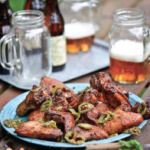
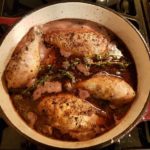
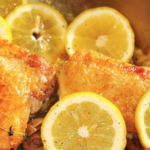
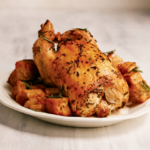
No Comments